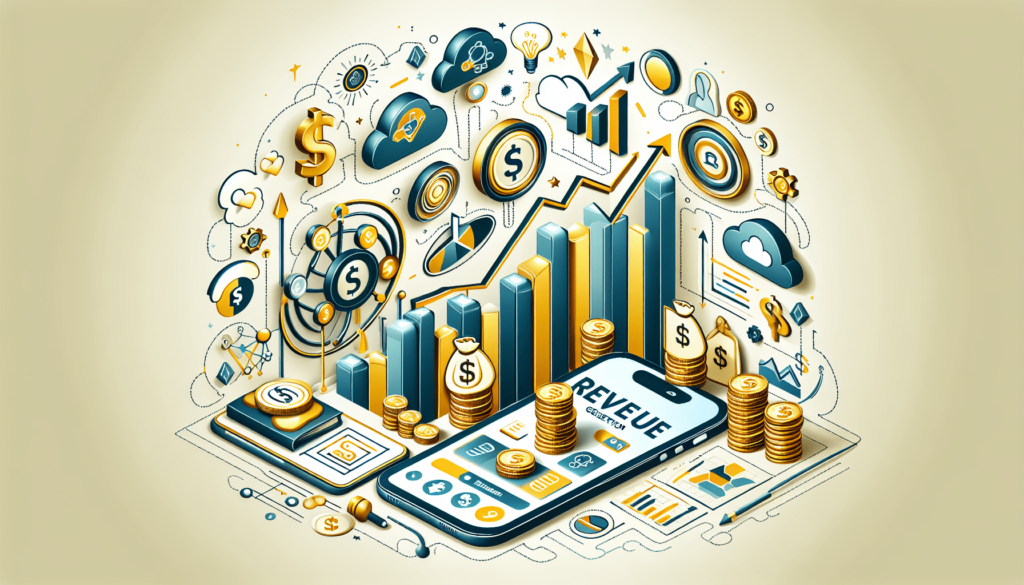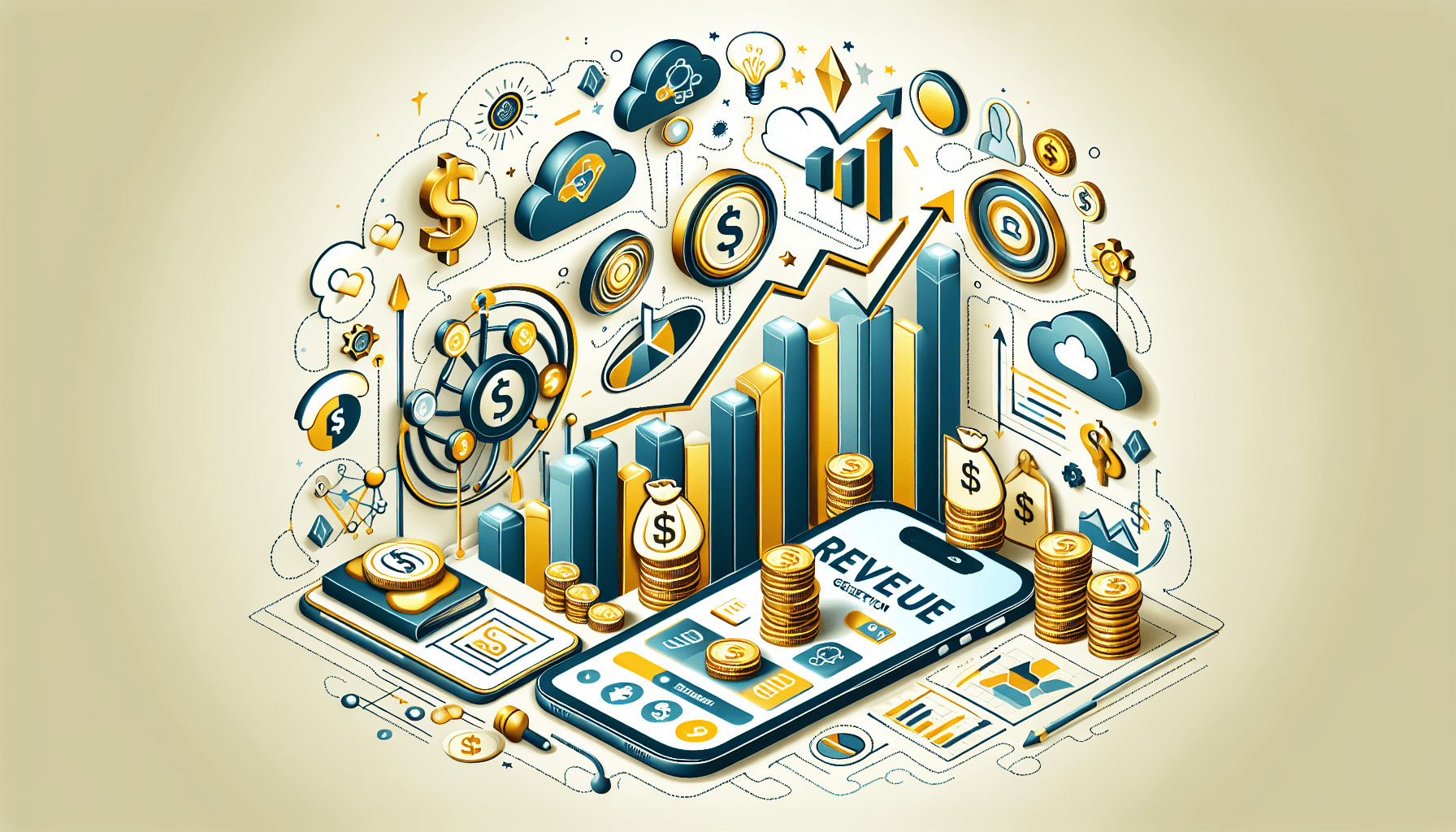In today’s fast-paced digital world, mobile apps have become an essential tool for businesses to engage and connect with their customers. With the ever-increasing number of smartphone users, generating revenue through mobile apps has become a top priority for companies across various industries. In this article, we will explore proven strategies that can help businesses maximize their profits and unlock the full potential of their mobile apps. From in-app purchases to advertising and subscription models, we will delve into the world of app monetization and provide valuable insights on how to effectively capitalize on this lucrative market. So, whether you’re a startup looking to make money or an established company aiming to enhance your revenue streams, join us as we unravel the secrets to generating revenue through mobile apps.
Unlock Earning Power: My $7 Mega Link Secret Revealed!
In-app purchases
In-app purchases have become a popular way for mobile apps to generate revenue. These purchases allow users to unlock additional features, access exclusive content, or enhance their overall experience within the app. There are several types of in-app purchases that developers can offer to their users.
Types of in-app purchases
-
Consumable: Consumable in-app purchases are items or features that can be used up or repurchased. Examples include virtual coins, extra lives, or power-ups in gaming apps.
-
Non-consumable: Non-consumable in-app purchases are items or features that users can purchase once and have access to permanently. This can include removing ads, unlocking premium content, or accessing additional levels in a game.
-
Subscriptions: Subscriptions are a type of in-app purchase that offers users access to premium features or content on a recurring basis. This can be offered monthly, quarterly, or annually and can provide a steady stream of revenue for developers.
Implementing in-app purchases
Implementing in-app purchases requires careful planning and integration within the app. Developers need to ensure a smooth user experience by making the purchasing process intuitive and seamless. Providing clear and concise information about the benefits of each purchase is also important to encourage users to make the purchase.
It is crucial to test the in-app purchase system thoroughly to identify any potential issues or bugs. Regular updates and bug fixes should also be provided to maintain a positive user experience.
Pricing and promotions
When determining the pricing for in-app purchases, it is essential to strike a balance between affordability and value. Conducting market research and analyzing similar apps can help determine the appropriate pricing ranges.
Offering promotions and discounts can be an effective way to attract new users or incentivize existing users to make purchases. Promotions can include limited-time offers, bundle deals, or exclusive discounts for loyal users. Regularly reviewing and adjusting pricing and promotions based on user feedback and app performance is crucial for long-term success.
Subscription model
The subscription model offers a recurring revenue stream for mobile apps. It allows developers to provide users with access to premium features or content for a subscription fee.
Advantages of subscription model
-
Predictable revenue: The subscription model provides developers with a predictable and consistent revenue stream. Monthly or annual subscription fees contribute to ongoing financial stability for the app.
-
Enhanced user engagement: Subscribers are more likely to engage with the app regularly to utilize the premium features or content they have access to. This increased engagement can lead to higher user retention rates.
-
Upsell opportunities: The subscription model provides an opportunity to upsell users to higher-tier plans or additional add-ons. By offering different subscription tiers with varying benefits, developers can cater to different user preferences and increase revenue potential.
Implementing a subscription model
To implement a subscription model, developers need to carefully consider the value proposition they can offer to subscribers. The premium features or content should provide clear benefits and enhance the overall app experience.
Offering a free trial period or a limited version of the app can help users understand the value of the subscription and encourage them to become paying subscribers. Clear communication about the benefits of subscribing and frequent reminders within the app can also improve conversion rates.
Offering exclusive content
To further entice users to subscribe, providing exclusive content or features can be highly effective. This can include early access to new features, ad-free experience, access to premium content libraries, or special perks such as discounts or rewards. Offering regular updates and fresh content ensures that subscribers feel they are receiving ongoing value for their subscription.

Life-Changing: How a Simple Link Brought Me Financial Freedom!
Advertisements
Advertisements are a common revenue-generating strategy for mobile apps. By integrating ads into the app, developers can generate revenue through advertising partnerships.
Types of mobile app ads
-
Banner ads: Banner ads are small ads that appear at the top or bottom of the app screen. They are non-intrusive and do not disrupt the user experience significantly.
-
Interstitial ads: Interstitial ads are full-screen ads that appear between app content. They can be displayed during natural breaks in the user flow, such as between game levels or when transitioning between app sections.
-
Native ads: Native ads are designed to blend seamlessly with the app’s user interface. They match the look and feel of the app, offering a more integrated and less disruptive ad experience.
Integrating ads into the app
To integrate ads into an app successfully, developers need to consider the placement and timing of the ads. They should avoid placing ads in critical areas or interrupting the user experience during crucial moments.
Strategic ad placement can enhance user engagement and encourage interaction with the ads. For example, placing ads in between levels of a game or during natural pauses can increase the likelihood of users noticing and engaging with the ads.
Ad placement and targeting
Targeted advertising is essential for maximizing ad revenue and user satisfaction. By displaying ads relevant to the user’s interests or demographics, the chances of clicks and conversions can significantly increase.
Utilizing user data and analytics to segment and target specific user groups can enhance the effectiveness of mobile app ads. Ad networks and platforms provide tools and technologies to target ads based on user preferences, location, behavior, and other demographic data.
Sponsorship and partnerships
Sponsorship and partnerships offer an alternative revenue stream for mobile apps. By collaborating with brands or businesses, developers can secure financial support in exchange for promoting sponsors within the app.
Identifying potential sponsors
To identify potential sponsors, developers should research brands or businesses that align with their app’s target audience, theme, or values. It is important to consider how the sponsorship can benefit both parties, ensuring a mutually beneficial partnership.
App developers can explore partnerships with local businesses, relevant industry leaders, or well-established brands that resonate with their app’s user base.
Negotiating sponsorship deals
When negotiating sponsorship deals, developers should outline the benefits and promotional opportunities they can offer to sponsors. This can include ad placements, mentions in app content, sponsored events or promotions, or exclusive discounts for app users.
Developers need to ensure that the terms of the sponsorship align with their app’s values and maintain a positive user experience. Clear communication and transparency throughout the negotiation process are crucial to building a mutually beneficial partnership.
Promoting sponsors through the app
To effectively promote sponsors through the app, developers can strategically integrate sponsored content or ads into the app’s user experience. This can include branded content, sponsored challenges or events, or exclusive offers and discounts provided by sponsors.
Developers should ensure that the promotion of sponsors is done in a way that does not disrupt the app’s overall functionality or user experience. Users should see the sponsor’s involvement as a valuable addition rather than an intrusive advertisement.

Daily Payday From Your Couch? Try now for the cost of a cup of coffee!
Freemium model
The freemium model offers a combination of free and premium features to users. This model allows users to access basic app functionalities for free while providing opportunities for them to upgrade to a premium version.
Benefits of freemium model
-
Attracting a larger user base: By offering a free version of the app, developers can attract a larger number of users who may be hesitant to pay upfront. This larger user base can potentially lead to increased word-of-mouth marketing and viral growth.
-
Upselling to premium features: The freemium model provides an opportunity to upsell users to premium features or content. This can be done by offering additional functionality, advanced features, enhanced customization options, or exclusive content.
-
Building user loyalty: By offering a free version of the app and continuously providing updates and improvements, developers can build a loyal user base. Users who find value in the app are more likely to convert to premium users over time.
Offering additional features or content
To entice users to upgrade to the premium version, developers need to carefully consider the additional features or content they offer. These should provide clear value and enhance the user experience.
The key is to strike a balance between the features available in the free version and those exclusive to the premium version. Offering a taste of the premium features in the free version can help users understand the value they will gain by upgrading.
Converting free users to premium
Converting free users to premium users requires a proactive approach from developers. This can include targeted marketing campaigns, personalized offers or discounts for specific user segments, or limited-time promotions to encourage users to upgrade.
Continuously interacting with users, addressing their feedback, and showcasing the value of the premium version can significantly increase conversion rates. Developers should prioritize building trust and loyalty with the free user base to increase the likelihood of them becoming paying customers.
Data monetization
Data monetization involves collecting and leveraging user data to generate revenue. Mobile apps generate a wealth of valuable user data that can be used for targeted advertising or sold to third parties in an anonymized format.
Collecting and analyzing user data
To effectively monetize user data, developers need to establish robust data collection processes. This can include gathering information such as user demographics, behavior patterns, preferences, and interaction data within the app.
Analyzing this data can provide valuable insights into user behavior, allowing developers to make informed decisions regarding app improvements and targeted advertising strategies.
Offering targeted advertising
One of the most common ways to monetize user data is through targeted advertising. By utilizing user data to create detailed user profiles, developers can offer highly targeted advertising opportunities to brands or businesses.
Targeted advertising increases the chances of conversions, as ads are delivered to users who are more likely to be interested in the products or services being advertised. This benefits both developers, who generate ad revenue, and advertisers, who can reach a more receptive audience.
Selling anonymized user data
Developers can also generate revenue by selling anonymized user data to third-party companies, such as market research firms or data analytics providers. Anonymizing the data ensures user privacy while allowing businesses to gain valuable insights into consumer behavior.
Before selling user data, developers must adhere to relevant data protection regulations and obtain user consent to collect and share their data. Transparency and clear communication with users regarding data collection and usage are essential to maintain user trust.
Shocking! This one link can pay you time and time again!
Affiliate marketing
Affiliate marketing is a performance-based marketing strategy where developers promote other companies’ products or services in exchange for a commission on referral sales.
Identifying suitable affiliate programs
Developers can identify suitable affiliate programs by researching companies or brands that align with their app’s target audience or theme. Affiliate networks provide a platform where developers can find a wide range of affiliate programs to choose from.
Choosing reputable affiliate programs and products that resonate with the app’s users ensures a higher likelihood of conversions and commission earnings.
Promoting affiliate products or services
To effectively promote affiliate products or services, developers can integrate affiliate links or banners within the app’s user interface. For example, a fitness app could promote fitness gear or nutritional supplements.
Developers should focus on providing authentic and valuable endorsements of the affiliate products or services to build trust with their users. This can be done through in-app content, blog posts, or social media promotions.
Earning commissions on referral sales
Developers earn commissions on referral sales when users make a purchase using their affiliate link. It is important to track conversions accurately to ensure accurate commission payouts.
Developers can optimize their affiliate marketing efforts by monitoring performance metrics, such as click-through rates and conversion rates. This allows them to refine their promotional strategies and focus on the most effective affiliate partnerships.
White labeling
White labeling refers to the practice of licensing an app’s source code or framework to third parties, who can then rebrand and customize the app to suit their brand or business.
Licensing the app for rebranding
To generate revenue through white labeling, developers need to offer licensing agreements that allow third parties to rebrand and modify the app. This can be a one-time licensing fee or a recurring revenue agreement based on usage or customization.
Developers should ensure that the app’s source code is well-documented and easily customizable to make the white labeling process seamless for third parties.
Providing customization options
Providing customization options is crucial to appeal to potential white label customers. This can include options to change the app’s color scheme, logo, branding elements, or even certain functionalities.
The customization process should be user-friendly and require minimal technical knowledge to ensure accessibility for a wide range of businesses or individuals seeking to rebrand the app.
Generating revenue through licensing fees
Developers can generate revenue by charging licensing fees to third parties who wish to white label the app. The licensing fees can be based on factors such as the level of customization required, the target market size, or the projected revenue potential for the white label customers.
Regularly reviewing and adjusting licensing fees based on market demand, competition, and customer feedback is necessary to maximize revenue generation through white labeling.
Unlock Earning Power: My $7 Mega Link Secret Revealed!
Crowdfunding
Crowdfunding offers developers an alternative method of funding app development by seeking financial support from backers in the form of donations or contributions.
Launching a crowdfunding campaign
To launch a successful crowdfunding campaign, developers need to create a compelling pitch that clearly outlines the app’s value proposition and potential impact. The pitch should resonate with potential backers and showcase how their contributions will make a difference.
Developers can leverage crowdfunding platforms such as Kickstarter or Indiegogo to reach a wide audience of potential supporters. It is crucial to set a realistic funding goal and create a timeline that highlights key milestones and deliverables.
Setting rewards for backers
To incentivize backers, developers can offer rewards based on the amount they contribute. These rewards can range from early access to the app, exclusive features or content, branded merchandise, or even personalized experiences such as meetings with the development team.
Offering diverse and attractive reward tiers ensures that backers feel recognized and valued for their support. Regular communication and updates throughout the crowdfunding campaign help build trust and maintain engagement with potential backers.
Using the funds for app development
Once the crowdfunding campaign is successful and the necessary funds are raised, developers can allocate the funds towards various aspects of app development, such as hiring additional developers, conducting thorough testing and quality assurance, marketing and promotion efforts, or ongoing maintenance and updates.
Transparency in fund allocation and regular updates on the progress of app development are essential for backers to feel confident that their contributions are being used effectively.
App analytics and optimization
App analytics and optimization involve monitoring user behavior and engagement within the app, using data-driven insights to make enhancements and improvements that maximize revenue generation.
Monitoring user behavior and engagement
App analytics tools allow developers to track user behavior, such as app usage patterns, session lengths, feature engagement, and conversion rates. These insights provide a deep understanding of how users interact with the app and identify areas for optimization.
By monitoring user behavior, developers can determine which features are most popular, where users may be experiencing obstacles or drop-off points, and which paths lead to conversions or revenue generation.
Making data-driven improvements
Using data-driven insights, developers can prioritize improvements and enhancements to the app that directly impact revenue generation. For example, if analytics reveal that a particular feature or section of the app has a high conversion rate, developers can allocate resources to optimize and further promote that feature.
Regularly reviewing and acting upon app analytics allows developers to stay agile and responsive to evolving user needs and preferences. A continuous improvement mindset ensures that the app remains relevant and generates revenue consistently.
Optimizing app performance for revenue generation
App performance optimization is crucial for revenue generation. Ensuring that the app loads quickly, minimizes crashes or bugs, and provides a seamless user experience contributes to higher user satisfaction, engagement, and conversions.
App optimization can include implementing A/B testing to compare different user interfaces, conducting usability studies to identify areas for improvement, or optimizing for different device specifications and operating system requirements.
By continually optimizing app performance, developers can enhance user experience, increase user retention rates, and ultimately generate more revenue through improved app performance.
Life-Changing: How a Simple Link Brought Me Financial Freedom!

